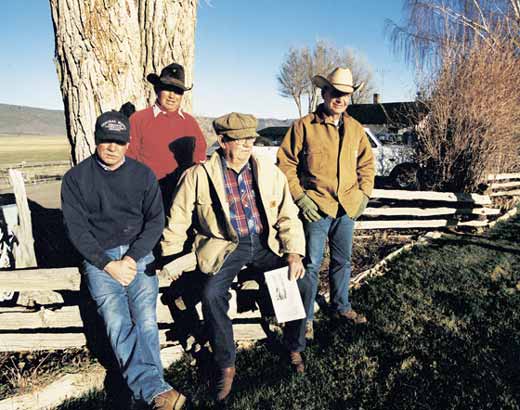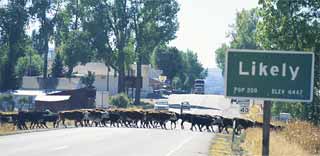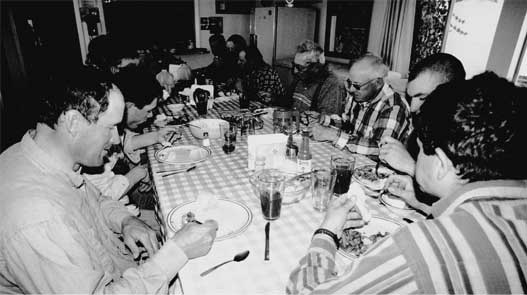|
|
|
| Subscriptions click here for 20% off! | E-Mail: info@rangemagazine.com |

|
The brothers Flournoy and their California spread. Sometimes the best part of working together is working apart. For the Flournoy brothers—Billy, John and Dave—their 131-year-old Likely Land and Livestock Company ranch in far northeastern California is both a division of duties and a unity of purpose. “We’re not in each other’s face all day long,” says Billy, “but we help each other.” John agrees that they’ve been able to work through “all those little problems” and get the job done. Dave believes the partnership thrives because the three are more than co-workers. “My brothers,” he declares with evident pride, “are two of the best friends I’ve got.” Billy, 61, is the cowboy who oversees the cattle operations. John, two years younger, is in charge of irrigation and hay operations. Fifty-year-old Dave is the mechanic, keeping the ranch’s fleet of work and personal vehicles operating. The ranch is located in Likely, a bucolic community in Modoc County, Calif. Theirs is a neat and tidy operation—no random debris, no clutter. They own 18,000 acres of deeded lands and run mostly black Angus, 1,400 mothers and
calves, along with 300 replacement heifers, 80 bulls, and 25 riding horses. Each brother and his family has a separate home on the ranch. There’s also a bunkhouse, a spacious shop that services “65 radiators”—their way of counting ranch and family vehicles—and, in a throwback to a mostly forgotten era, a cookhouse. The cookhouse has been a ranch tradition for as long as the family can remember. Billy sits at the head of the table, flanked by Dave and John. Further down are ranch hands. Some, like Bill Bronner and Miguel Madrigal Torres, have been taking places at the table for more than 30 years. Six or seven people work full-time. Others are added seasonally. The day before, choices at the noon meal included shepherd’s pie, fresh rolls, green beans, coleslaw, cauliflower, pitchers of iced tea, juices and water and, for dessert, blackberry cobbler with ice cream. Today, it’s broiled chicken with gravy and mashed potatoes, accompanied by a hearty selection of vegetables. “They eat pretty good,” says cook Annie Hurdle. “They eat a lot.” For the past three years she’s been on the job at 4:30 each morning baking bread and getting breakfast on the table by 6 so the crew can be out by 7 a.m. After cleaning up, she takes a quick break until returning for the major meal at noon. Usually, eight or nine people sit around the table. Some days, there might be 15 or more. But meals in the cookhouse aren’t just about eating. The cookhouse is where the Flournoys line out work plans and the brothers agree that group meals are an important part of the operation. Folks trying to track them down know the best time to call is noon. “That’s when the phone rings off the hook,” says Dave. “Everybody knows this is the time to catch us.” “We don’t work together all that much, so this way I know what Johnny and Davey are doing,” explains Billy. “By eating with the crew we know what’s going on. It’s good for everybody.” It’s a time to prioritize work and ask for help if it’s needed. At noon, Billy outlines plans for the afternoon branding. The chairs are filled with family, friends and neighbors who’ll lend a hand. Flournoys have ranched the Likely area since 1871, when the brothers’ great grandfather, John D. Flournoy arrived and homesteaded. “They told him there was a nice valley up here,” says Billy. In a community of about 200 people, the Flournoy family and other branches of the clan make up a significant portion of the population. Billy has never really left the ranch. After a few years of college he realized he longed to be in Likely working cattle. John worked as a civilian flight instructor before being drafted into the Army during the Vietnam war. He returned 32 years ago and has no plans to move. Dave spent several years experiencing other lifestyles until his brothers apparently willed him back to the ranch 29 years ago. Billy, comfortable in his weathered Stetson, coordinates all things involving the cattle—branding, moving and selling. During the summer, Billy’s work is mostly horseback, although he sat out a few months after knee surgery. “That’s
all I do all summer, move cattle. The old days of just putting your cattle out in the summer and leaving ’em are gone. I still get a lot of satisfaction out of moving, branding and working with cattle.” John oversees irrigation, including the ranch’s carefully designed network of ditches and 3,000 acres of laser-leveled fields that produce much of the ranch’s grass hay. Yield annually ranges from 4,000 to 6,000 tons. The family uses most of the hay themselves, and sells the rest. John finds satisfaction managing water. Wells and the south fork of the Pit River provide water for fields that are flood irrigated. He’s an advocate of laser-leveled fields, which “save us water and time, and time is really important. A laser-leveled field irrigates quickly, finishes on time, dries quicker. In agriculture we live off what we grow.” He’s fascinated and philosophical about water needs and demands. “It looks like water is going to be our undoing, or maybe our salvation,” says John. He envisions a time when the ranch will raise only dryland crops, run “a handful of cattle” and sell water to users further south where there are 200 growing days. At 4,000 feet above sea level, Likely’s season is half that. Dave mostly works in the shop, where he keeps the ranch’s fleet of venerable tractors, bulldozers, excavators and pickup trucks running. “I grew up in this shop. We had an old mechanic who got me started as a kid,” he says. “Billy and Johnny are not very mechanical so they leave it to me. I don’t get to do much horseback riding, but I really enjoy it when I go.” Dave and Rigo Zendejas (an employee since 1991), work most days in the shop. They often work side-by-side, devising ways to keep machinery and vehicles functioning. “It is quite a challenge,” Dave says. “We have nothing that’s worth anything to trade in. We don’t get any new anythings. It’s just not in our budget. A helluva lot of this machinery has been here all my lifetime.” Don, 84, says his sons “all get along good.” He’s driving a well-worn but working-just-fine truck, probably a 1954 GMC. The windshield is a spiderweb of fractured glass. The interior is nearly stripped to the steel frame. It’s loaded
with 25 to 30 bales of chopped hay. Seemingly on its own, the rig follows the deep grooves along fences where the milled hay is ejected into feed troughs lined with hungry heifers. “I bought this truck 25 years ago for 500 bucks,” Don says. “I’ve seen the change from horses to trucks. The biggest change was from stacking loose hay to baling. I guess it’s easier with the machinery. We used to have 50 guys putting up hay. Now it’s 10 or 11, but good farm help is hard to find.” Don remains an equal partner in the ranch. Mother, Shirley, kept the ranch books for years. In case of disagreements, the brothers often rely on their father as the final arbitrator. “I don’t know how my dad did it,” John says, “but somehow he instilled in us the ability to want to work together.” Billy adds, “My dad and mom support us 100 percent. If we said we’re going to sell all those cows and raise ground squirrels, I’m sure he’d say, ‘Let’s give it a try’.” Apart from work, the brothers follow their own interests. Each fall, Billy and his wife Athena head to the San Francisco Bay area where they’re regulars at San Francisco 49ers and Stanford University football games. They also spend time with their daughters, Dawn DeSimone in Medford, Ore., and Roxanne Hagedorn, in Montague, Calif. Of granddaughter Gabrielle DeSimone, Athena says, “She’s a cowgirl. She loves cattle and ranching.” Nick Van Loan, Roxanne’s son, thrives during his ranch visits with his proud grandfather. “I think he’s going to like ranching,” Billy says, “but you never know.” John and his wife, Sydney, have two sons. Daniel’s ending a stint in the Army. Miles is an ag business student at Shasta Community College. “He does seem interested,” says John of Miles’ possible future on the ranch. “But I’ve reminded him he can be in agriculture without being in production ag. He has to decide if he wants a good life or a good living. I haven’t pushed him.” “They’ve seen us work so hard for so little,” echoes Dave. “I tell Aaron, ‘If you see something you like, go out there and do it’.” His son, Aaron, is a senior at Modoc High School. Dave and wife, Joanne, also have a daughter, Monica Hays, who lives in nearby Alturas. Away from the ranch, Dave races stock cars. This afternoon the brothers, two sons, grandson, neighbors and friends like Delbert Reese, Norman Vogh, and Clark and Rhonda Morris, are branding 100 heifers. Ropes are flying. Branding irons are frying. Billy is in his element, sometimes flopped atop roped heifers, other times roping from horseback. Don stops by, but only to watch. On the ground, Dave instructs Aaron, Miles, Nick and young wannabe buckaroos—“Lift under there and get that jaw”—while John gives the roped heifers inoculations. “It’s a great challenge. It’s clean, and you get to work outside. I never know where I’m going to be any given day,” says John. “When there are 50 different things you could do each morning, it beats a factory job all to heck.” “I can ride, I can do it all,” explains Dave. “What I like about ranching is I’m not stuck doing any one thing. One day I’m working in the shop, the next I’m heading to Lakeview to get a part for a truck. Today I’m out here.” He points at fields alive with sandhill cranes, ducks, geese, owls, eagles and deer. “You can’t abuse a piece of ground for 130 years and be successful.” Dave, John and Billy are all working hard, successfully managing their ranch lands, enjoying their work—and each other. The brand burned onto the heifers is an “F” leaned on its side. Lazy F. Lazy Flournoys? No way. Lee Juillerat works for the Herald & News in Klamath Falls, Ore. He cares about cow country and the people who live there. |
||||||||||||
|
Fall 2002 Contents To Subscribe: Please click here or call 1-800-RANGE-4-U for a special web price Copyright © 1998-2005 RANGE magazine For problems or questions regarding this site, please contact Dolphin Enterprises. last page update: 04.03.05 |
|||



